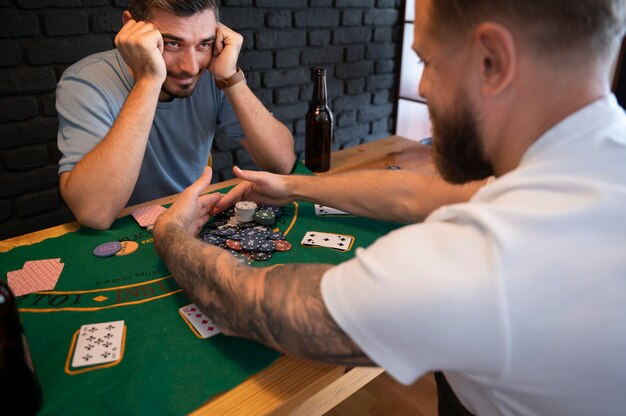Bluffing in Poker – Mastering the Art of Breaking the Rules

Poker is more than just a game of luck–it’s a game of skill, psychology, and strategy. While the rules of poker are straightforward, one of the most intriguing and essential tactics in the game is bluffing. Bluffing involves deceiving your opponents into thinking you have a stronger or weaker hand than you actually do. In this way, it almost seems like you’re “breaking the rules” of fair play, but in reality, it’s a calculated part of the game.
For many players, mastering the art of bluffing is what separates the amateurs from the professionals. It’s not just about lying; it’s about timing, reading your opponents, and maintaining control of your own emotions. Done correctly, bluffing can shift the dynamics of a hand and even lead to victory when your cards would otherwise spell defeat.
In this article, we’ll explore the psychology behind bluffing, the key strategies involved, and when to deploy this high-risk move in your poker game. By the end, you’ll understand why bluffing is a strategic necessity and how to perfect this skill without letting it backfire.
Why Bluffing is Essential to Poker Strategy
Bluffing is one of the most crucial elements in poker, transforming it from a simple game of chance into a complex contest of skill and psychology. Without bluffing, poker would be reduced to a game of only playing strong hands, making it predictable and far less engaging. Bluffing allows players to manipulate their opponents’ perceptions, turning weak hands into potential winners.
Mastering the art of bluffing is essential for anyone looking to succeed in poker. It provides an opportunity to capitalize on the uncertainty of your opponents, forcing them to make difficult decisions and potentially fold superior hands. By integrating bluffing into your strategy, you can maintain an unpredictable playstyle, which is crucial in long-term success at the poker table.
The Importance of Bluffing in a Well-Rounded Strategy
Bluffing is not just about deception; it is a calculated risk designed to maximize your gains and minimize your losses. A well-timed bluff can be the difference between winning a big pot or losing out entirely. It becomes essential when facing skilled opponents who can read standard betting patterns and react accordingly.
- Psychological Pressure: Bluffing adds psychological pressure to the game, keeping your opponents on edge.
Key Techniques to Successfully Bluff Your Opponents
Bluffing in poker is a complex strategy that requires skill, timing, and an understanding of human psychology. It’s not just about pretending to have a strong hand, but about manipulating your opponents’ perception and making them believe in your story.
To bluff successfully, players need to know when to apply pressure, when to retreat, and how to remain unpredictable. In this section, we’ll cover the key techniques to help you master the art of bluffing and use it to your advantage at the poker table.
1. Choose the Right Moment to Bluff
Timing is everything in poker. Bluffing too frequently or in the wrong situations can lead to easy detection. Pay attention to the dynamics of the game and your opponents’ tendencies. The best time to bluff is when the pot is worth the risk and your opponents are showing weakness.
2. Control Your Table Image
How you present yourself at the table can influence your bluff’s success. If you’ve been playing conservatively, a sudden aggressive move might be more believable. On the other hand, if you’ve been bluffing often, your credibility may be lower, so choose your moments carefully.
3. Master the Art of Bet Sizing
The size of your bet can make or break your bluff. A strong bluff typically requires a well-calculated bet that mimics
Common Mistakes to Avoid When Bluffing in Poker
Bluffing is an essential part of poker, but even the most experienced players can fall into traps if they’re not cautious. While a well-timed bluff can turn the game in your favor, making mistakes during a bluff can have costly consequences.
To become a more successful bluffer, it’s crucial to recognize the most common pitfalls players encounter. By understanding these errors, you can adjust your strategy and increase your chances of success.
Top Bluffing Mistakes to Avoid
- Bluffing Too Often: Overusing the bluff is a common mistake. If your opponents notice you’re bluffing frequently, they’ll be more likely to call your bets.
- Bluffing Against the Wrong Opponents: Trying to bluff players who are known for calling every hand or who can’t be intimidated is a bad strategy. Bluff against players who are likely to fold under pressure.
- Ignoring Table Image: Your table image–how your opponents perceive you–should influence your bluffing decisions. If you’re seen as a tight player, a bluff might work better than if you’re seen as loose and reckless.
- Failing to Consider Bet Sizing: Your bluff needs to be convincing. A bet that’s too small might not scare your opponents, while one that’s too large could be seen as suspicious.
- Bluffing on the Wrong Boards: Bluffing on a board that’s likely to hit your opponent’s range is risky